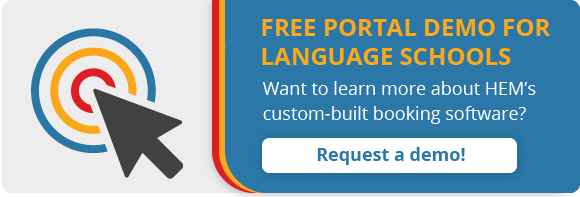
We’re living in a time where there is no shortage of software options for schools, but finding one that perfectly fits your needs? Well, that’s another story.
With so many different application portal options to choose from, it can be difficult figuring out which one is best for your school. That’s why we’ve put together a guide that outlines the must-have features to help you narrow your search and figure out which system best suits your needs.
From custom field options to a multitude of payment gateways, your portal software should have features to streamline the application process from the moment prospects decide to apply right up to enrollment. Read on to learn which boxes you need to check off if you’re in the market for some new student application software.
1. Unique Account Creation for Agents, Parents, Students, and More
When browsing online application systems, many schools strive to make their decisions from the lens of prospective students. What are they looking for? What expectations do they have? How can we make life as easy as possible for them?
While it’s always good to keep your prospective students in mind for any recruitment endeavor, don’t forget about any other stakeholders that impact the admissions process.
If parents apply on their kids’ behalf, or if agents are responsible for some of your recruits, ensure your school’s application system supports their needs as well.
The feature you’ll be looking for in this case is the ability for students, parents, agents, and any other applicable actors to create unique accounts. This allows them to access custom applications tailored to their needs.
Example: The login screen for HEM’s application portal. The ability for parents and agents to create their own accounts allows them to submit applications on behalf of multiple students.

The unique account feature also makes the application process infinitely easier for everyone involved. Users can begin their application, save as they go, close the application, and return to it at any point.
Any student knows that the application process can often be tedious and take a while to complete, so this feature prevents the possibility of them losing the information they’ve entered if they decide to take a break or accidentally exit out of the application window.
Example: A confirmation email from Wongu University’s student portal. When you create an account on Wongu’s site, you receive a link to it in an email that allows you to access your application at any time. As stated in the email, the application answers are automatically saved in your account as well.

If you’re looking to digitize your application process, a simple form or fillable PDF will get the job done—but how well it will get the job done is another matter. Without the ability to create unique accounts, parents and agents may experience difficulties filling out forms on behalf of multiple students. The inability to save the application as you go also proves inconvenient for everyone involved.
If your school is considering investing in student application software, make sure to keep an eye out for the features that make your lives, as well as that of your prospective students, a whole lot easier. Both your prospects and your admissions staff will surely appreciate it! After all, the happier your prospects are with their admissions experience, the more likely they are to enroll. And the more time your staff saves, the more time they have to get prospects across the finish line.
2. Custom Field Options in Online Application Systems
One of the most basic must-have features that should be included in any student application portal is the ability to fully customize each aspect of your applications. This means being able to choose from a variety of field types, fit with a number of different parameters that allow you to fully personalize your forms.
That way, each particular application can be as simple or as robust as you’d like. It’s especially important to have these options if you have a variety of applications—some for long-term programs and others for individual courses, for instance.
Example: A sample field editor in HEM’s Student Application Portal. You can customize every aspect of each form field, from design elements to more complex components such as smart fields and validation rules.

Schools should also be able to customize each type of field they use in their application form. From dropdown menus to check boxes to fields where prospects can write out their response, each field serves a unique purpose and, used correctly, can help speed up the application process significantly.
Example: The various field types available in HEM’s student application portal. Some fields are already pre-populated (the “Date” field offers a calendar, for instance) making it as easy as possible for schools to build custom applications.

The features and components offered in the builder section of your application software have a major impact on the overall effectiveness of your application process. It will also make it much easier for your school to create applications catered to your target audience.
3. Online Application Portals Should Offer Multiple Payment Gateways
One of the main benefits of investing in student application software is the instant digitization of each part of the application process. You don’t have to worry about integrating different payment options to your school’s site, or about the different protocols required to ensure safe and secure online payments. Your application portal does that for you.
However, when examining the payment features a portal offers, make sure that yours offers a variety of payment options.
These selections should include popular payment methods, such as PayPal and Visa, as well as more niche options that your target audience favours. For international students, payment methods such as Stripe, as well as the school-specific Flywire, tend to be popular options. But as with any marketing endeavor, consider first what applies most readily to your school and put it at the top of your priority list.
Example: The various payment options in HEM’s application portal. Depending on the application, you can add different payment options based on your school’s needs.
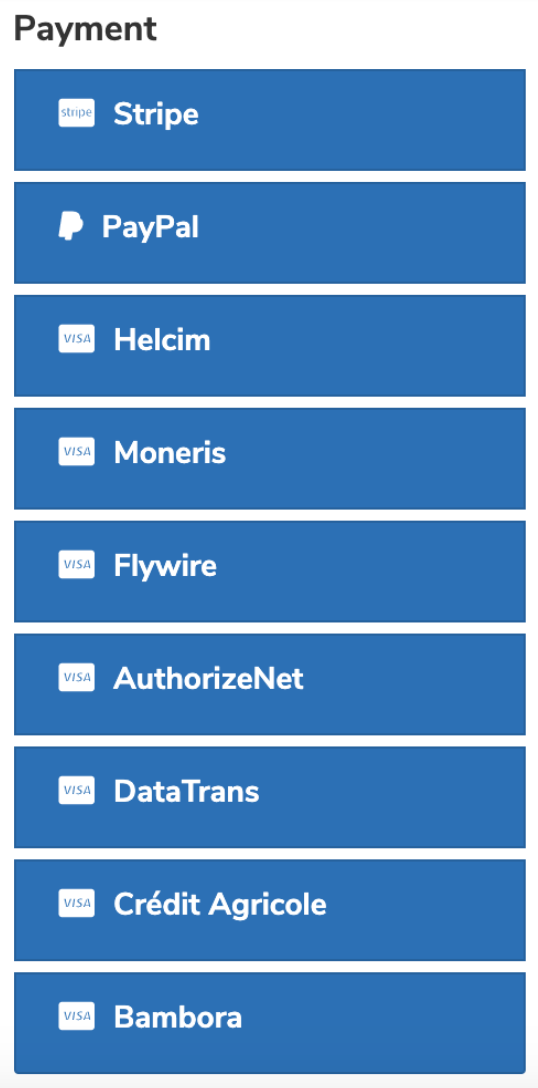
That way, you have a variety of different payment options for your prospects. And the more choice you offer, the more likely they are to follow through on submitting their applications.
Example: Payment options available to students at San Francisco University.
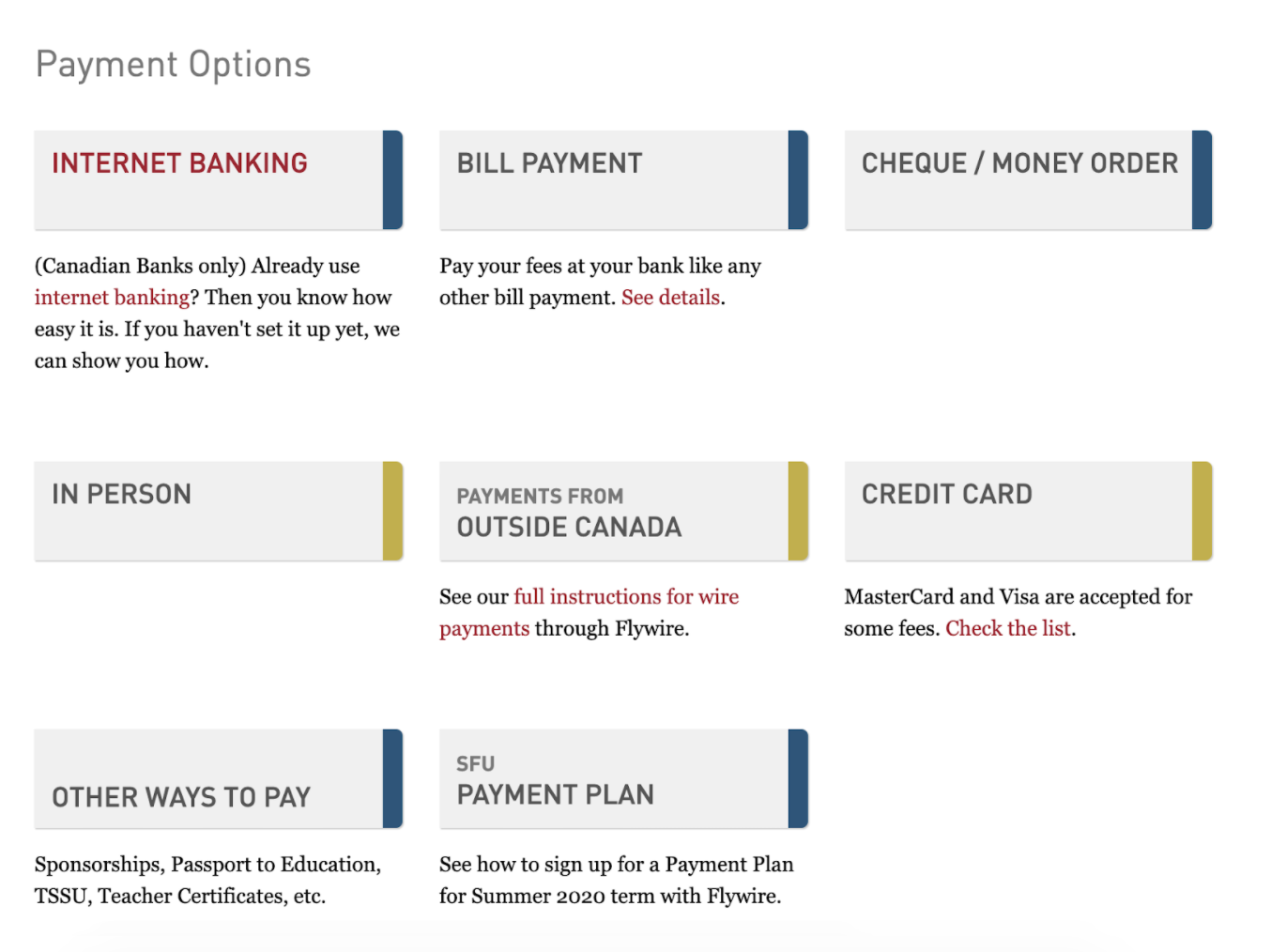
Having this feature in your portal is also a signifier of your school’s commitment to accessibility. Offering a variety of payment options shows that you understand the need for secure payment methods for prospects in a wide variety of locations and financial situations.
4. Ensure Additional Student Recruitment Tools in your Online Application System
It’s not only students that expect perfection when going through an application process. Schools should also be blown away by the features that application software offers when they go to make that investment.
This means that the portal should go beyond what it says on the tin— namely, to streamline the online application process—and offer additional tools that take things to the next level.
Quote Builders for Schools
For many schools, especially those that offer shorter term programs, a quote builder can be an excellent precursor to the application process itself. This feature allows prospects to customize their dream program—fit with different accommodation, course, and activity options—and calculate its cost.
Example: International House uses CoursePricer to offer prospects the ability to calculate the cost of their studies before moving on to the application process.

But not all quote builders are created equal. Your school should be able to customize it completely, with different sections (such as accommodations and airport costs) based on the options your school offers.
Another helpful feature to look for in a quote builder—especially for language schools—is the ability to adjust prices based on high and low season.
Regardless of school type, your quote builder should also provide a direct pathway to booking. A quote builder provides a great segway to the application process, so if the journey stops after prospects have finished their quote, you’re missing a valuable component of the process.
Example: The last stage in HEM’s Quote Builder. Along with the summary of their quotation, prospects have the opportunity to have their quote emailed to them, or go straight to booking.
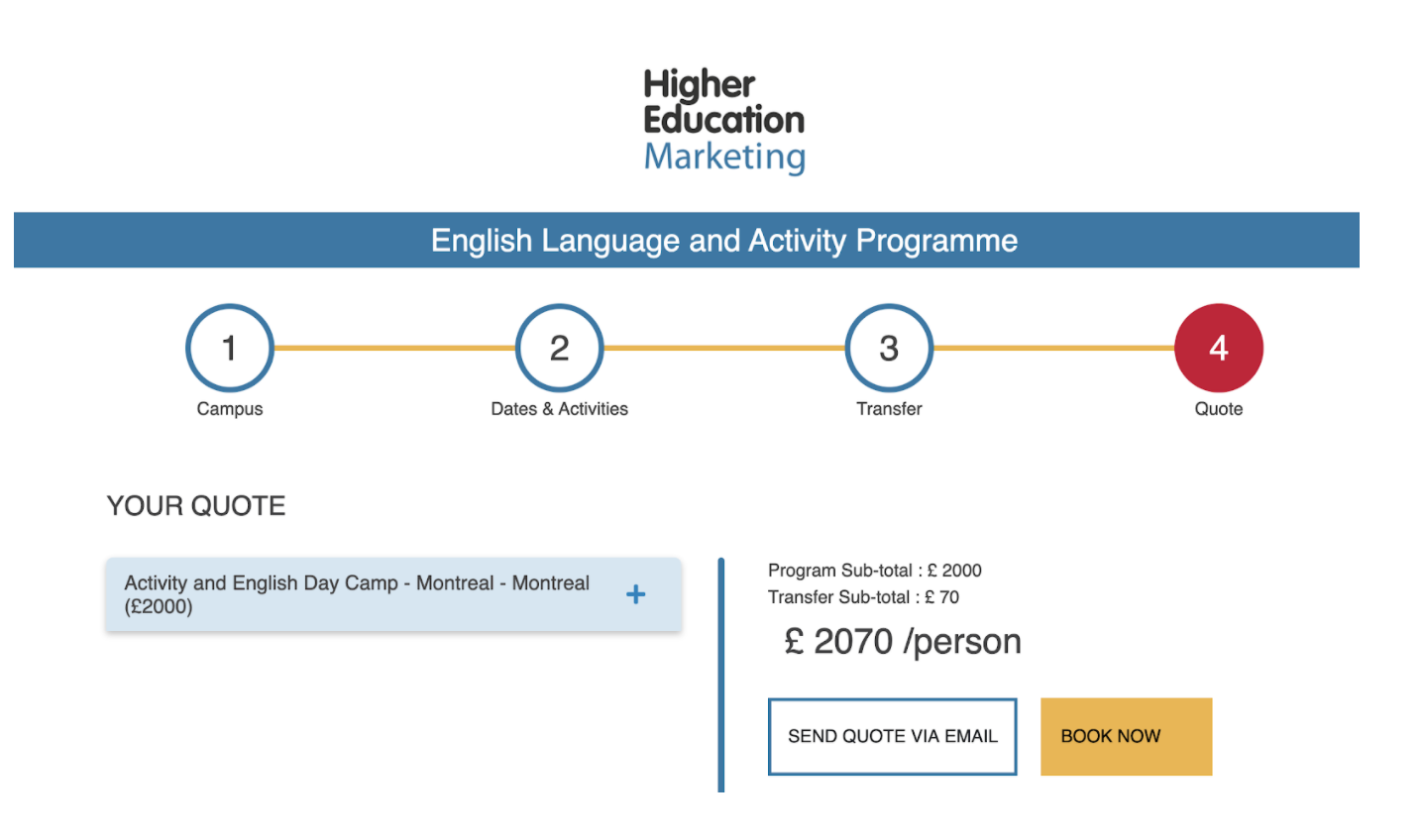
Virtual Admissions Assistant
Imagine if your application software could make your prospects’ higher ed decision for them? While this idea may have been unthinkable 15 years ago, it’s a possibility now that there are digital tools that provide all the resources and information your prospects need to finalize their higher ed journey.
HEM’s Virtual Admissions Assistant, for instance, functions similar to a quote builder in that prospects can explore different course and campus options—but instead of just looking at the dollars and cents, they can access a wide variety of resources like videos and links for each selection:
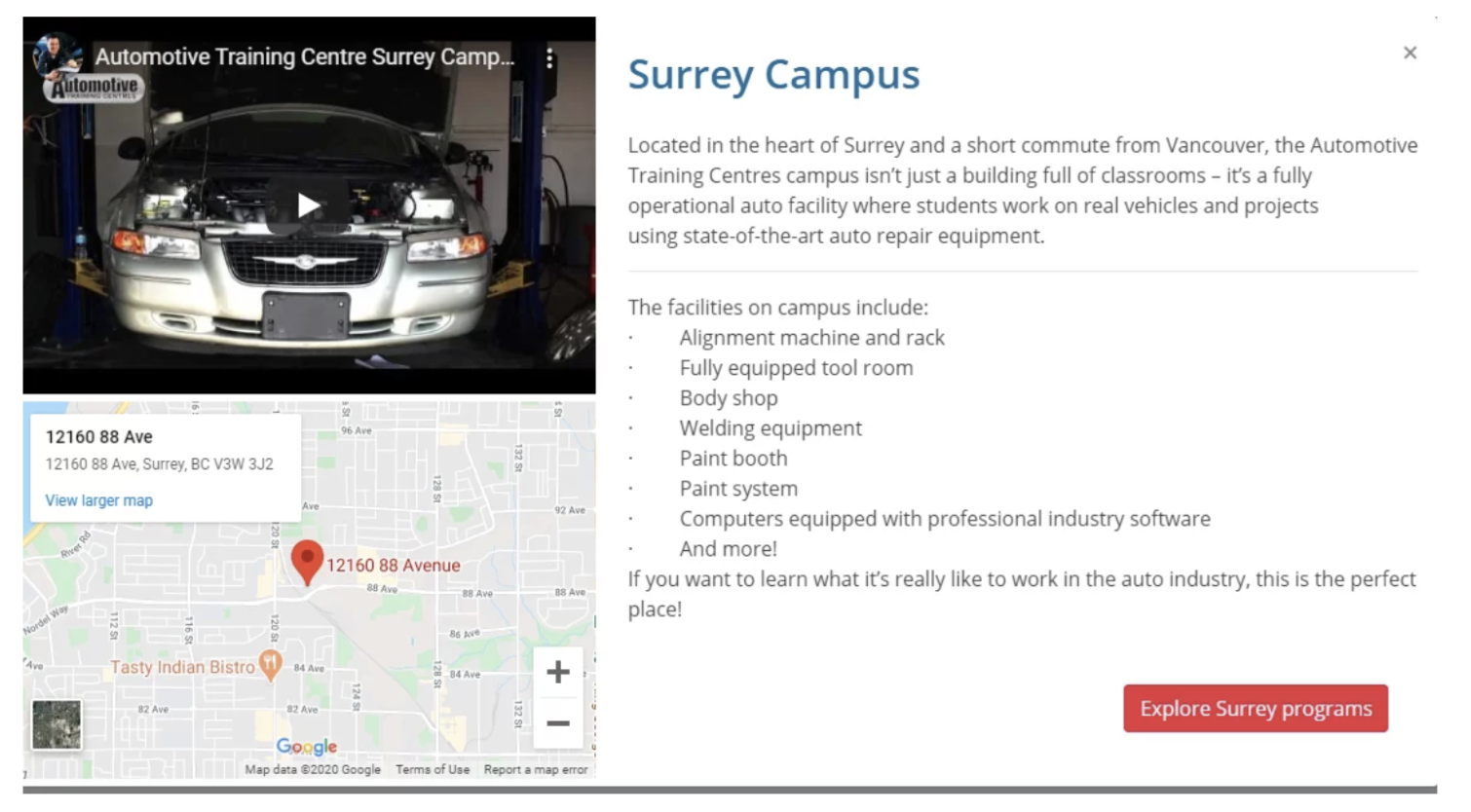
If a student experiences difficulties navigating the software, or wants to connect with your school, they can get help from the chat box widget or request a call with your school’s admissions team. At the end of the process, the prospect will receive a summary of their selections, just as they would if they generated a quote.
Features like this, which add extra value to the application process, work wonders for bridging the gap between prospects that are interested in your school and those that are ready to apply.
5. Make Sure Your Online Application Portal Has Robust Monitoring Capabilities
Your student application portal should be able to provide an optimum admissions experience from start to finish.
It’s easy to focus on the first part of the equation, because it generally refers to things you can easily see—such as the design of the application portal and the various features it offers. The last part, however, is easy to neglect, despite the important part it plays in your overall recruitment strategy.
Not only should your school’s portal provide a robust application builder, it should also provide equally comprehensive methods of monitoring your application success. That way, you can understand how many leads you have in the pipeline, how many have successfully applied, and how effective your overall recruitment efforts are.
With that being said, your application portal should have ample monitoring features and make it easy for your team to access these key statistics.
For example, as soon as you log into HEM’s Student Application Portal, you’ll be greeted with some general reports, such as how many applications are in process and which channels are driving these applicants:

To gain more specific insights into the status of particular applications, simply visit that menu on HEM’s portal for easy viewing:

You can also check the application status of individual students in the Applicants menu. This section shows which application a student is completing, what their payment status is, and whether or not the contact is associated with a particular agency:

When you’re looking for student application software, pay close attention to its monitoring capabilities. Not only because this data allows you to continually improve your application process—but because these features make it easy for your team to review completed applications and keep track of enrollment numbers.
6. The Ability to Integrate with CRM for Schools
If you’ve made it this far, you’ll know that there are plenty of things your application portal can do for your school from before the process starts to after it ends.
But if you really want to make sure you make the most out of your application portal, ensure it has the ability to connect with your CRM. This seemingly simple feature can make the world of difference when it comes to monitoring, tracking, and following up with leads.
Having this feature in your portal also means that any prospect who creates an account in it will automatically appear in your CRM, so you can monitor all your leads in one place.
Example: A sample contact database in Mautic CRM after being integrated with HEM’s Student Application Portal. As you can see, some are in the process of booking, while others have completed their applications in their entirety.

You can then use the various features your CRM offers (such as email, SMS, and direct call capabilities) to create campaigns for those who’ve started but not finished their applications. It’s possible that these prospects may be having difficulties with the application process, or still haven’t made up their minds on your school. These campaigns should ensure prospects get the help, advice, and encouragement they need to complete the process.
Example: A sample email that is triggered when someone hasn’t completed an application without 48 hours of starting it.

Beyond singular follow-up efforts, this integration feature also allows your school to create workflows directed at admitted students, which increases their chances of following through on their intention to enroll. This recruitment tactic is especially important for universities, business schools, law schools, and other education institutions where prospects tend to apply to more than one school.
Example: Email workflow for admitted students. The email angles are aimed at converting those who are still on the fence about their higher ed decision, as well as getting those who’ve settled on your school excited for their studies.

These are just a few ways you can use your CRM to boost the chances that highly interested leads end up applying at your school. If your portal offers additional features such as a quote builder or admissions assistant, you can also connect these to your CRM to aid in your follow-up efforts. The possibilities are truly endless when you invest in an online application portal that offers a wide range of features tailored to your school’s application needs.

